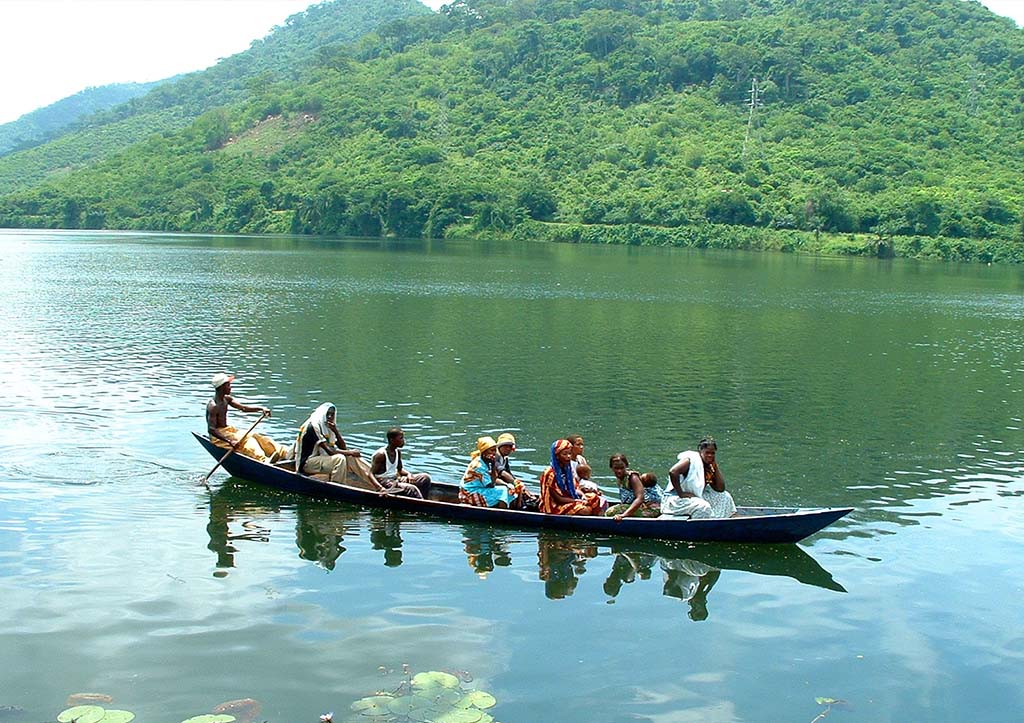Ghana has two major lakes namely the Volta and Bosumtwi lakes.
Lake Volta is human-made while Lake Bosumtwi is a natural water body. As early as 1915, Albert Ernest Kitson, a geologist had floated the idea of constructing a dam in Ghana. The actual construction was launched in 1961 by Dr. Kwame Nkrumah, the first president of Ghana and was completed in 1965.
Lake Bosumtwi is the only natural lake in Ghana, is situated within an ancient impact crater that is said to be about 10.5 kilometres (6.5 mil) in diameter. It is about 30 km (19 mi) south-east of Kumasi the capital of Ashanti and is a popular recreational area. With about 30 villages near crater lake Lake Bosumtwi, with a combined population of about 70,000. The most popular amongst the villages where tourists usually settle is Abono.
The forming of the lake has two historical backgrounds, the traditional legend and the scientific background.
Science says that, the lake was formed as a result of an asteroid impact. It has been found that, before the asteroid impact, the area was a lush rainforest filled with animals. Following the impact, the resulting crater filled with water forming Lake Bosumtwi.
Periods of heavy rainfall filled the crater with water, causing the lake level to rise above the lowest points of the rim.
The legends say that in 1648 an Ashanti hunter named Akora Bompe from the city of Asaman was chasing an injured antelope through the rainforest. Suddenly, the animal disappeared in a small pond. It was as if this body of water wanted to save the animal’s life. The hunter never got the antelope, though he settled close to the water and started catching fish. This place he named “Bosomtwe”, meaning “antelope god”. This story suggests that at that time the lake level was very low. The large dead trees standing offshore in the lake also evidence this, for they are over 300 years old.
The following centuries saw several wars about the lake as both the Ashanti and the Akim clashed, each claiming the area. The Ashanti prevailed. Each village in the lake area has its own shrine or fetish grove. With the arrival of Christianity, some of people gave up former beliefs, though many continue to seek traditional help in bad times or against diseases.
The Abrodwum Stone is held to be the spiritual centre of the lake. Here, when there is such poor fishing it is considered a bad omen, the lake people sacrifice a cow. This act is celebrated in the presence of his majesty, the Ashanti king, the Asantehene himself. In the ceremony, the cow’s innards are given to the stone and the rest is thrown into the lake. The crowd rushes into the water with cutlasses and axes to take their share of the meat. This is an event very much worth seeing. However, as such an omen depends on various factors, it is hardly predictable.
There is a traditional taboo against touching the water with iron and modern boats are not considered appropriate. The padua, a wooden plank requiring considerable skill to maneuver, is the legitimate method. Other taboos such as not washing, bathing or throwing effluents into the Lake that were formerly strictly observed, aided in maintaining the purity and health of the Lake.
Lake Volta, the largest artificial reservoir in the world based on surface area, is contained behind the Akosombo Dam which generates a substantial amount of Ghana’s electricity. It is completely within the country of Ghana and has a surface area of 8,502 square kilometres (3,283 sq mi; 2,101,000 acres). It extends from Akosombo in the south to the northern part of the country.
The lake is formed by the Akosombo Dam, which was originally conceived by the geologist Albert Ernest Kitson in 1915, but whose construction only began in 1961 with completion in 1965. Because of the formation of Lake Volta, about 78,000 people were relocated to new towns and villages, along with 200,000 animals belonging to them. About 120 buildings were destroyed, not including small residences, as over 3,000 square miles (7,800 km2) of territory were flooded.
The Akosombo Dam provides electricity for much of the country, as well as for export to Togo, Benin, and nearby countries, to earn foreign exchange. Lake Volta is also important for transportation, providing a waterway for both ferries and cargo watercraft. Since the huge lake lies in a tropical area, the water remains warm year-round naturally. Given good management, Lake Volta is the location of a vast population of fish and large fisheries.
The lake also attracts tourism, and tourist cruises visit the island of Dodi.
SOURCES: https://en.m.wikipedia.org/wiki/Lake_Bosumtwi.
https://en.m.wikipedia.org/wiki/Lake_Volta


